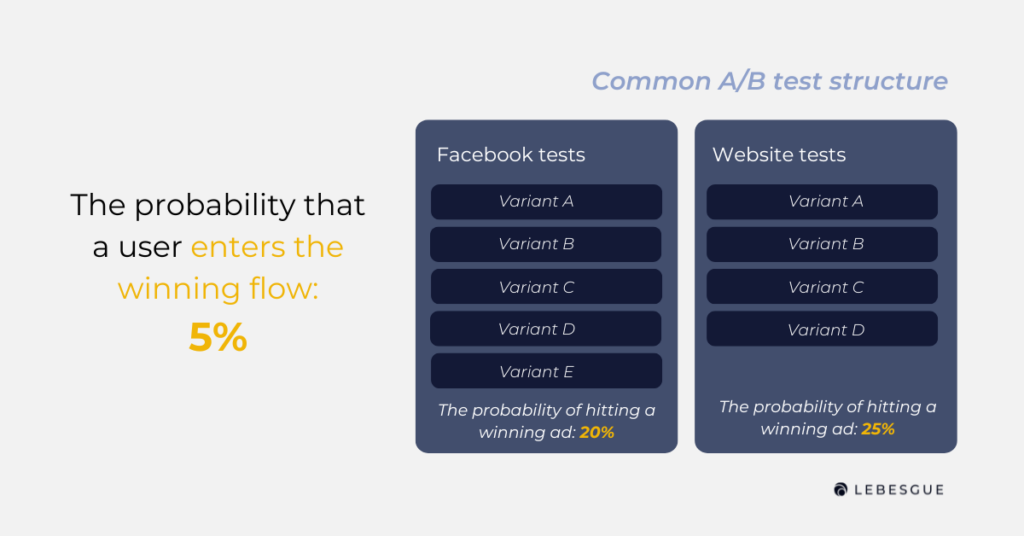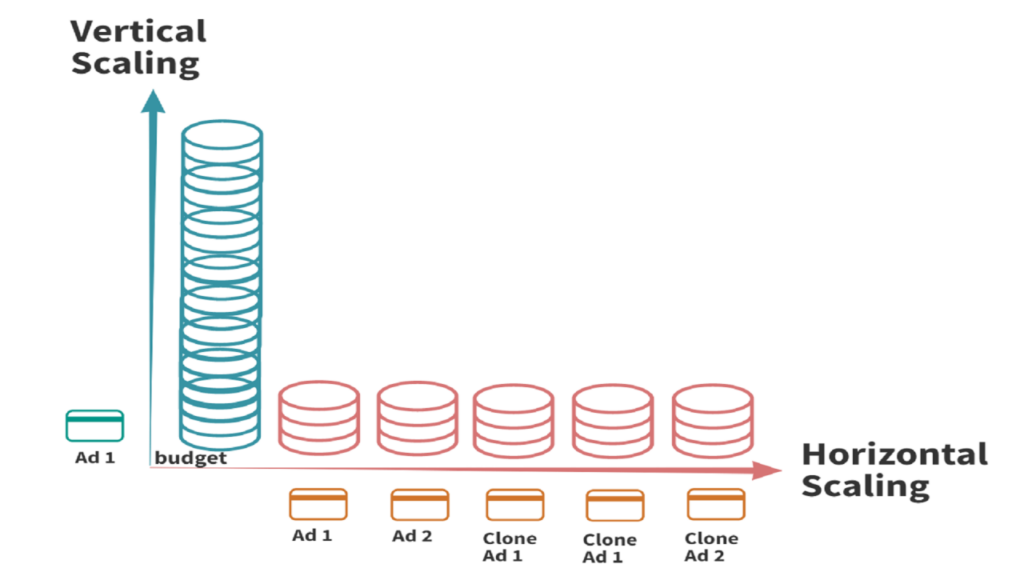In this post, we’ll outline five practical strategies to help you effectively scale Facebook ads for optimal growth.
From optimizing targeting to managing budgets, these actionable tactics are tailored to improve your ad campaigns and deliver better results. Whether you’re just starting or looking to refine your advertising approach, this blog post will provide invaluable insights to elevate your Facebook advertising efforts.
Also, we recently hosted a webinar on ‘Common Mistakes in Scaling Ad Campaigns’ a few weeks ago. You can catch the recording by clicking the button below.
Scaling Facebook Ads
Scaling Facebook ads involves expanding them to reach more audiences, allowing you to show your ads to new groups of people interested in your offering. This expansion can lead to increased sales because you’re reaching a larger audience.
Furthermore, when your ads are successful, increasing their reach can potentially earn you even more revenue.
Staying competitive in the market is crucial, and scaling your ads can help you stay ahead by reaching more people before your competitors do, enabling you to grab the attention of potential customers first.
Additionally, scaling provides you with more data to analyze, allowing you to identify what’s working and what’s not. This insight empowers you to make informed decisions to improve your ads in the future.
Vertical and Horizontal Scaling
Vertical and horizontal scaling are two strategies for scaling Facebook ads. These strategies refer to different approaches for expanding and optimizing your advertising efforts on the Meta platform.
- Vertical scaling Facebook ads involves increasing the budget in existing ad campaigns to reach a larger audience or increase the frequency of ad impressions within a single campaign.
- Horizontal scaling Facebook ads, on the other hand, involves adding new ad sets to a campaign or duplicating successful ads with a good ROAS to expand the reach to a broader audience.
Both vertical and horizontal scaling strategies are used to maximize the sales and effectiveness of Facebook advertising campaigns, but they do so in different ways. They guide how you allocate resources, adjust campaign settings, and manage your overall advertising strategy on the platform.
How to Scale Facebook Ads
In this blog post, we’ll discuss effective strategies for scaling Facebook ads that have shown promising results. To effectively scale your Facebook ads, consider implementing the following strategies:
- Broad targeting
- Advantage + placements
- Audience exclusion
- Keep an eye on competitors’ strategies
- Increase your advertising budget
Let’s see how to use each of these strategies for scaling Facebook ads.
Broad targeting
Our first recommendation for successful Facebook ads is to use broad targeting. We’ve found that campaigns do best when we let Facebook’s algorithm work without too many rules. This means Facebook can figure out which people are most likely to buy from you. The trick is to set up your ads to focus on getting people to actually purchase your products.
But we don’t just leave it completely open. We do give Facebook some basic guidelines, like age and location.
Why are we so sure that broad targeting is the way to go?
Our analysis of more than 15,000 e-commerce businesses tells us that when you have to choose between Lookalike and Broad targeting, Broad is better. It brings in more revenue for each dollar you spend on ads. On average, Broad targeting gives you 113% more ROAS than Lookalike targeting.
Also, Broad targeting is usually less expensive and gives you higher ROAS. It helps you make more revenue from your ads without spending as much.
However, it’s important to say that here you must optimize your campaigns for purchase, not traffic.
Advantage + placements
Using Advantage+ placements is similar to broad targeting. When you don’t put too many restrictions, Facebook’s algorithm tends to perform better.
Advantage+ placements let you get the best results from all default placements. This means Facebook will distribute your ad budget across different placements based on where they’re likely to perform best.
If one placement isn’t doing well, the algorithm will focus on other available placements that offer better opportunities.

We wouldn’t say this confidently without data to back it up. So, we tested manual versus Advantage+ placements. The results were clear: Advantage+ placements won.
Cost per acquisition (CAC) decreased by 50%, while cost per click (CPC) decreased by 150%.
In another test, we found that Instagram performs better than Facebook, but only when combined with automatic placements. This shows that using a wide range of placements allows the algorithm to place ads where they’re most likely to convert at the lowest cost.
But regardless of our results, we encourage you to test it out yourself and let the performance decide.
Audience exclusion
When you’re scaling your Facebook ads, it’s crucial to consider audience exclusion. This means separating two different groups of audience.
Our recommended structure to scale Facebook ads is to create two separate ad campaigns: one for reaching out to new potential customers (prospecting audience) and another for reconnecting with an audience who have already visited your website or interacted with your business (retargeting audience). It’s really important not to mix these two audiences in the same campaign.
When you’re trying to figure out how much it costs to get new customers, you need accurate data. If you mix the audience you’re already reaching out to again with the new audience you’re trying to attract, it can mess up your cost calculations. It might look like getting new customers is cheaper than it is.
By keeping these audiences separate, you can clearly understand how much it truly costs to acquire new customers. This helps you make better decisions based on accurate data.
Check out how to keep your audience separated by creating custom audiences.
Competitors’ strategies
The next recommendation is to keep an eye on your competitors. Checking competitors’ strategies when scaling Facebook ads provides valuable insights and benefits:
- Market Intelligence: Understanding what your competitors are doing helps you stay informed about industry trends and changes in the competitive landscape.
- Benchmarking: Analyzing competitors’ strategies allows you to benchmark your performance against industry standards and identify areas for improvement.
- Identifying Opportunities: Observing your competitors’ successes and failures helps you discover new opportunities and potential gaps in the market that you can capitalize on.
- Optimization: Learning from competitors’ strategies enables you to optimize your campaigns more effectively, leading to better performance and results.
- Staying Competitive: Keeping tabs on competitors ensures you remain competitive in your industry and helps you make informed decisions to stay ahead.
Read more about Best Practices for Facebook ads competitor analysis.
Increasing advertising budget
When you want to spend more budget on your Facebook ads to reach more audiences and get better results, it’s important to do it carefully.
Here’s how:
First, look at all your ads and see which ones are doing the best. These are the ads that are getting the most clicks, likes, or most importantly for e-commerce – sales.
Instead of spending a lot more budget all at once, start by adding a little bit more money to your best ads every few days. A good rule is to increase the budget by about 20% each time.
Keep an eye on your ads to see what happens when you spend more on them. Look at things like how many people are clicking on your ads or purchasing your products. If your ads keep doing well even with more budget, you can keep adding more money to them.
But be careful not to spend too much too quickly. You want to make sure that spending more on your ads is actually making you earn more.
Mistakes When Scaling Facebook Ads
Now that we cover the best practices to scale your Facebook ads, let’s see the most common mistakes businesses are making when scaling their ads.
Testing everything simultaneously
Testing everything simultaneously refers to the mistake of trying to test too many variables or strategies at once when scaling Facebook ads. This can include testing multiple audience segments, ad creatives, bidding strategies, or optimization techniques all at the same time.
The problem with this approach is that it makes it difficult to accurately assess which variables contribute to success or failure. When too many variables are changed simultaneously, it becomes challenging to isolate the impact of each change on ad performance.

Instead, it’s advisable to adopt a more focused and systematic approach to testing. Start by testing one variable at a time, such as ad creative. Monitor the performance of the test carefully and gather meaningful data before making further adjustments or introducing additional tests.
By testing variables sequentially and methodically, you can gain a clearer understanding of what strategies are most effective for your specific goals and audiences. This approach allows for more informed decision-making and optimization, leading to better overall campaign performance.
Missing best practices on Facebook ads
The next mistake when scaling Facebook ads is missing best practices.
Missing best practices on Facebook ads refers to the mistake of neglecting to follow established guidelines and recommendations for running successful ad campaigns on the platform.
Best Practices as of January 2025:
- Advantage+ Placements: Use Advantage+ placements for an average of 20% higher ROAS
- Lookalike Audiences: Outdated and negatively impact your CPM
- Single Ad Per Ad Set: Use a single ad per ad set in prospecting ads – 30% higher ROAS on average
- Manage Creative Fatigue: Keep ad frequency up to 3 for prospecting and up to 7 for retargeting to avoid creative fatigue
- Optimize for Purchase Event: Directly optimizing campaigns for the “Purchase” event can lead to a 150% increase in ROAS, compared to “Traffic”, “Awareness” or “Lead gen” optimization.
- Budget Allocation: Invest over 85% of your budget into prospecting to achieve a 15% lower blended CAC.
Missing out on competitor strategies
Missing out on competitor strategies refers to the mistake of neglecting to analyze and learn from the creative approaches used by competitors in their Facebook ads.
Competitors’ ad copy and messaging can offer valuable insights into language, tone, and messaging strategies that effectively communicate with the target audience. Ignoring competitor messaging may result in missed opportunities to create compelling ad copy that resonates with the audience and drives desired actions.
In summary, by failing to analyze and learn from competitor creatives, you miss out on valuable opportunities to understand visual trends, messaging preferences, and creative strategies that resonate with the shared audience.
Summing Up
To sum up, scaling your Facebook ads in 2025 requires a strategic approach and a deep understanding of your target audience. By implementing the five proven strategies outlined in this blog post – from refining targeting to optimizing budgets – you can effectively expand your reach and drive growth through Facebook advertising.




